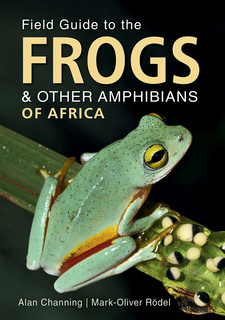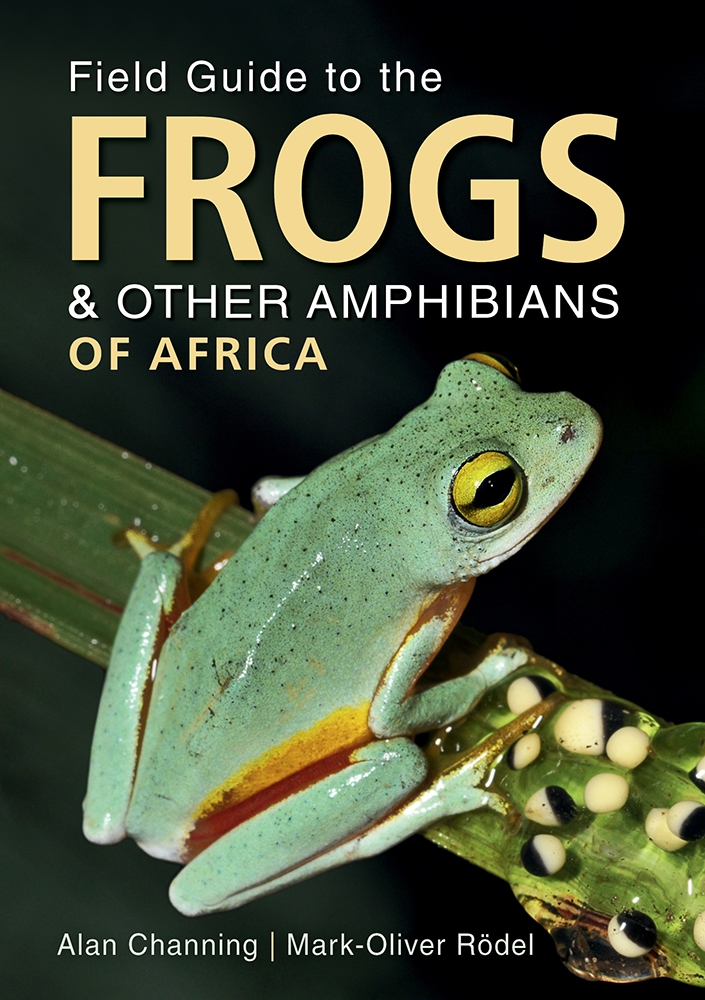Field Guide to the Frogs & other Amphibians of Africa, by Alan Charming and Mark-Oliver Rödel

Field Guide to the Frogs & other Amphibians of Africa, by Alan Charming and Mark-Oliver Rödel. Penguin Random House South Africa. Imprint: Struik Nature. Cape Town, South Africa 2019. ISBN 9781775845126 / ISBN 978-1-77-584512-6
Field Guide to the Frogs & other Amphibians of Africa by Alan Charming and Mark-Oliver Rödel. The following text explains the arrangement of the guide.
Identifying amphibians is often not an easy task. Some species can only be identified positively by using call analysis, detailed morphological examination, or DNA sequencing. However, with the help of the structured information in Field Guide to the Frogs & other Amphibians of Africa - group and species accounts, distribution maps, and photographs - enthusiasts should be able to identify most of the species encountered in the field.
Photographic Guide
The photographic guide to groups (page 18) is an aid for identifying the group to which a specimen belongs. It provides a photograph and key characters to every group included in this book.
Group Accounts
Before attempting to identify a specimen to species level, read the group-level text preceding each set of species and ensure that the specimen in hand aligns with the features discussed. Species from different groups can be superficially similar. For instance, it is easy to confuse a Puddle Frog with a Squeaker, although these frogs are not even closely related. The group accounts list the characters of the respective species and thus will help you to avoid such mistakes. For instance, all Puddle Frogs have a tarsal tubercle, a character that is never present in any Squeaker. The group accounts provide important identification information (an account of features common to all the species that fall within that group), along with the number of known species, the distribution of the group, and notes on their breeding where this is useful for identification.
Species Accounts
For each species, the following information is given: English name (1) and scientific name (2) (when already described scientifically); maximum size of males and females, measured from the tip of the snout to the end of the body in frogs, or the total length of salamanders and caecilians (if known) (3); description of features useful for identification (4); distribution (with a map (5) to indicate the known range); habitat (6) in which adults are found; and a brief description of the advertisement call (7). Behavioural and ecological features are noted under 'Biology' (8) if these are useful for identification in the field or unique to the particular species. The IUCN Red List status (9) is given as a symbol, as explained on page 13. One or more photographs (10) of most species appear on the opposite page. If no photographs are available, this is indicated after the name.
Distribution and habitat
It will help you to identify specimens if you take into account both the habitat and and the area where you have found them. Most species survive only in particular habitats that serve their species needs and have small distribution ranges. [...]
Alan Charming has studied African frogs and tadpoles for many years. He has worked in many parts of the continent, and authored three books on African frogs and tadpoles. He is well known in the academic community, and is associated with the University of the Western Cape, and North-West University in South Africa.
Mark-Oliver Rödel works with his team at the Natural History Museum in Berlin, Germany. For many years he has studied the taxonomy, biogeography and ecology of African amphibians. He has a special interest in how species react to environmental changes. He has written more than 300 scientific and popular publications, including several books.
This is an excerpt from Field Guide to the Frogs & other Amphibians of Africa, by Alan Charming and Mark-Oliver Rödel.
Title: Field Guide to the Frogs & other Amphibians of Africa
Authors: Alan Charming; Mark-Oliver Rödel
Publisher: Penguin Random House South Africa
Imprint: Struik Nature
Cape Town, South Africa 2019
ISBN 9781775845126 / ISBN 978-1-77-584512-6
Softcover, 15 x 21 cm, 407 pages, throughout colour photos
Charming, Alan und Rödel, Mark-Oliver im Namibiana-Buchangebot
Field Guide to the Frogs & other Amphibians of Africa
The Field Guide to the Frogs & other Amphibians of Africa is the first guide ever to cover the 788 frogs, 23 caecilians and 4 salamanders of Africa.

